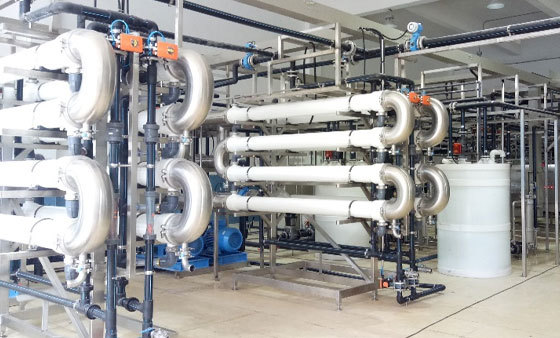 Esperanto
Esperanto
 Shqiptare
Shqiptare
 Euskara
Euskara
 Zulu
Zulu
 Latinus
Latinus
 Cymraeg
Cymraeg
 தமிழ்
தமிழ்
 Slovak
Slovak
 Slovak
Slovak
 Afrikaans
Afrikaans

Application
Landfill leachate
Release time: 2022-05-09
It involves external MBR and concentrate reduction treatment and stripping and deamination technology.
The external MBR has been maturely used in biochemical treatment to improve the aerobic reaction capacity of the front end by trapping activated sludge.
In order to dispose of excess leachate as soon as possible in some landfills, most of them are treated with DTRO membranes. The treated concentrate is recharged to the landfill, resulting in the enrichment of the landfill leachate with high salt, high ammonia nitrogen and high COD substances, which brings great difficulty to the later treatment. The resulting concentrated solution has a high treatment cost, and the traditional biochemical treatment method cannot operate, and can only be treated by softening and evaporation. A large amount of softened sludge and miscellaneous salts will become hazardous waste, causing great environmental risks. , so it is urgent to find a new and once-and-for-all solution.
Through the integration of softening technology, deammonia technology, electrodialysis technology, advanced oxidation technology, membrane filtration technology, membrane purification technology, causticization technology, evaporation crystallization and other technologies, the problem of landfill leachate concentration after emergency treatment due to high-pressure DTRO has been solved. The problem of high salt, high ammonia nitrogen and high COD wastewater caused by water recharging is difficult to treat. Through this invention, the resource utilization and near-zero discharge of such wastewater are realized, which not only solves this difficult wastewater treatment problem, but also recovers Among them, ammonia nitrogen and humic acid have been realized as resources. The calcium sulfate, calcium carbonate and magnesium hydroxide miscellaneous salts produced in the treatment process are used as raw materials for cement production through the synergistic treatment of the cement plant, and the sodium chloride obtained after evaporation and crystallization The purity of by-products reaches the industrial salt standard, and the treated external drainage reaches GB16889-2008 (Table 2 standard). This invention not only solves such difficult organic waste water, but also brings great environmental and social benefits.
PLUM has developed the deammonia pretreatment, leachate, and concentrated liquid membrane advanced treatment technology of old landfill leachate developed through experiments, which solved the difficult problem of old high ammonia nitrogen landfill leachate of Shanghai Laogang Waste Disposal Co., Ltd. We use the self-developed deammonia pretreatment system to reduce the ammonia nitrogen in the leachate from about 4000mg/l to below 1000mg/l without adding any chemicals to adjust the pH value, and the ammonia nitrogen removal rate is greater than 75%. The removed ammonia nitrogen is recovered, and finally the removed ammonia nitrogen is made into ammonium bicarbonate fertilizer. This process is the first in the field of percolation treatment and fills the technological gap.
Compared with the traditional biochemical system, the deamination pretreatment system developed by our company has lower investment cost and operating cost. The more important significance is that this process saves a lot of carbon sources, reduces the design capacity of the biochemical pool, and at the same time recovers Ammonia nitrogen in wastewater consumes a large amount of carbon dioxide gas during the synthesis of ammonium bicarbonate, reducing greenhouse gas emissions.
The advanced membrane treatment process in the latter stage of the MBR system, our company's landfill leachate full-volume treatment technology, and the equipment configuration and control method of our fully automatic continuous concentration and separation system are more stable and reliable, with high efficiency. The recovery rate reaches an astonishing 96%, the COD of the produced water is less than 100mg/L, and the operating cost is lower, and the cost of membrane treatment per ton of water is controlled within 12RMB. Since 2019, the technology has passed the appraisal of experts in the industry, and the process is at the world's leading level in the field of leachate treatment.

Recommended product
 Hefei-Anhui-China
Hefei-Anhui-China +8618226169015
+8618226169015 haoyangyu@plummembranes.com
haoyangyu@plummembranes.com







 haoyangyu@plummembranes.com
haoyangyu@plummembranes.com
 8618226169015
8618226169015
 Message
Message
